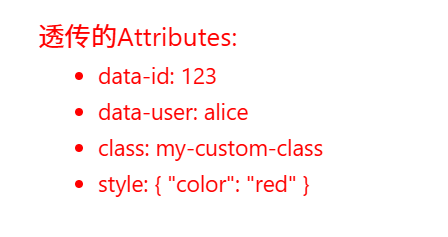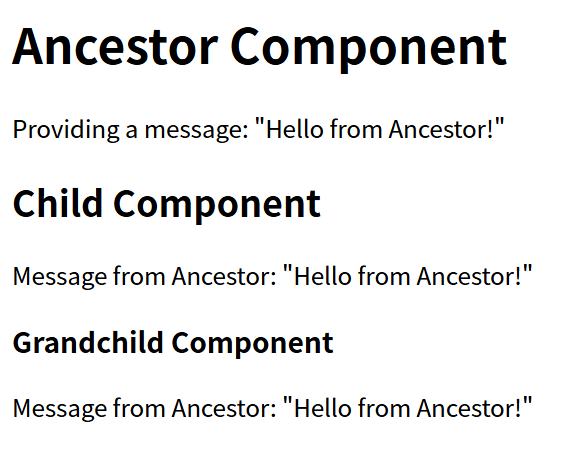1. 透传attributes
在组件上使用透传attribute : 当你在父组件中使用子组件时,你可以添加一些attribute到子组件上,即使这些attribute没有在子组件的props中声明。
父组件:
<!-- 父组件,例如 ParentComponent.vue -->
<template>
<div>
<MyComponent
data-id="123"
data-user="alice"
class="my-custom-class"
style="color: red;"
/>
</div>
</template>
<script>
import MyComponent from '../components/MyComponent.vue';
export default {
components: {
MyComponent
}
};
</script>
<style>
/* 父组件样式 */
</style>子组件:
<!-- MyComponent.vue -->
<template>
<div v-bind="$attrs">
<h3>透传的Attributes:</h3>
<ul>
<li v-for="(value, name) in $attrs" :key="name">
{{ name }}: {{ value }}
</li>
</ul>
</div>
</template>
<script>
export default {
inheritAttrs: false, // 禁用默认的attribute继承行为
};
</script>
<style>
/* 组件样式 */
</style>显示效果:

当然如果你想在控制台打印出来,你可以打印 this.&attrs
<script>
export default {
inheritAttrs: false, // 禁用默认的attribute继承行为,
mounted() {
// 在组件挂载后,打印透传的attributes
console.log('透传的Attributes:', this.$attrs);
},
};
</script>2. 插槽
就是直接在组件中插入对应的模版
2.1 简单点的插入:
ChildComponent.vue:
<template>
<div>
before
<slot></slot>
<slot></slot>
<slot></slot>
after
</div>
</template>
<script setup>
</script>
<style>
</style>父组件:
<template>
<div class="home">
<ChildComponent>
<div>{{hello}}</div>
</ChildComponent>
</div>
</template>
<script setup>
import { ref } from 'vue'
import ChildComponent from '../components/ChildComponent.vue'
const hello = ref('Hello world! 2024')
</script>显示效果:就是将插入的div代替了子组件的slot位置

2.2 在插槽指定的位置,插入指定的值
ChildComponent.vue:
<template>
<div>
<slot name="header"></slot>
<slot name="content"></slot>
<slot name="footer"></slot>
</div>
</template>父组件:
<template>
<div class="home">
<ChildComponent>
<template #header>
<p>This is the header slot</p>
</template>
<template #content>
<p>This is the content slot with a variable: {{ contentVariable }}</p>
</template>
<template #footer>
<p>This is the footer slot</p>
</template>
</ChildComponent>
</div>
</template>
<script>
import { ref } from 'vue'
import ChildComponent from '../components/ChildComponent.vue'
export default {
components: {
ChildComponent
},
setup() {
const contentVariable = ref('This is some content.')
return { contentVariable }
}
}
</script>3. 依赖注入
为了便于祖孙之间数据的传输,
3.1 祖组件向子组件和孙组件传递数据示例
祖组件:
<template>
<div>
<h1>Ancestor Component</h1>
<p>Providing a message: "{{ message }}"</p>
<ChildComponent />
</div>
</template>
<script>
import { provide, ref } from 'vue';
import ChildComponent from '../components/ChildComponent.vue';
export default {
components: {
ChildComponent
},
setup() {
const message = ref('Hello from Ancestor!');
provide('ancestorMessage', message);
return { message };
}
}
</script>子组件:
<template>
<div>
<h2>Child Component</h2>
<p>Message from Ancestor: "{{ ancestorMessage }}"</p>
<GrandchildComponent />
</div>
</template>
<script>
import { inject } from 'vue';
import GrandchildComponent from '../components/GrandchildComponent.vue';
export default {
components: {
GrandchildComponent
},
setup() {
const ancestorMessage = inject('ancestorMessage');
return { ancestorMessage };
}
}
</script>孙组件:
<template>
<div>
<h3>Grandchild Component</h3>
<p>Message from Ancestor: "{{ ancestorMessage }}"</p>
</div>
</template>
<script>
import { inject } from 'vue';
export default {
setup() {
const ancestorMessage = inject('ancestorMessage');
return { ancestorMessage };
}
}
</script>然后你会发现子和孙组件都是通过inject来接收数据,而祖组件只需要通过provide发送数据
显示效果:
